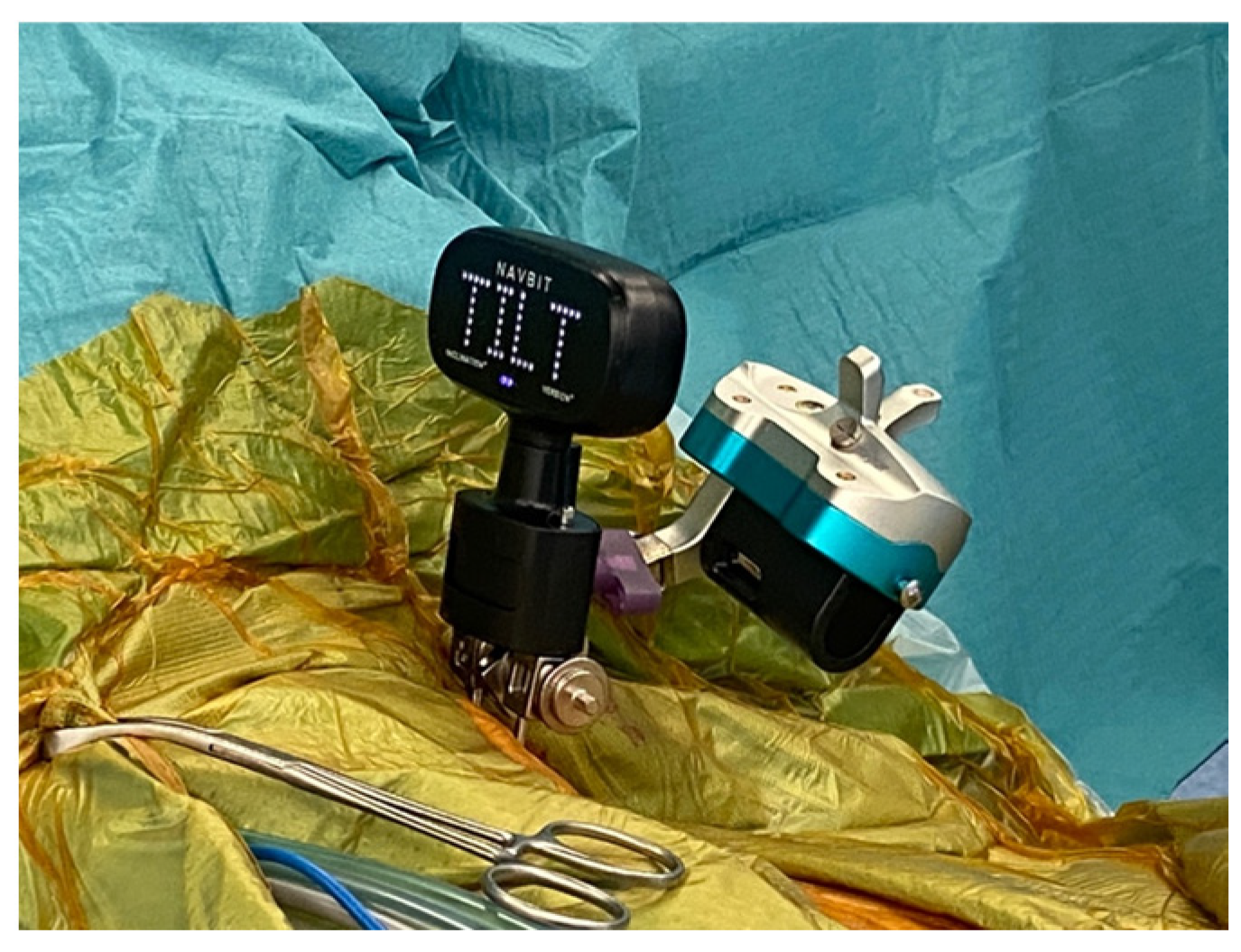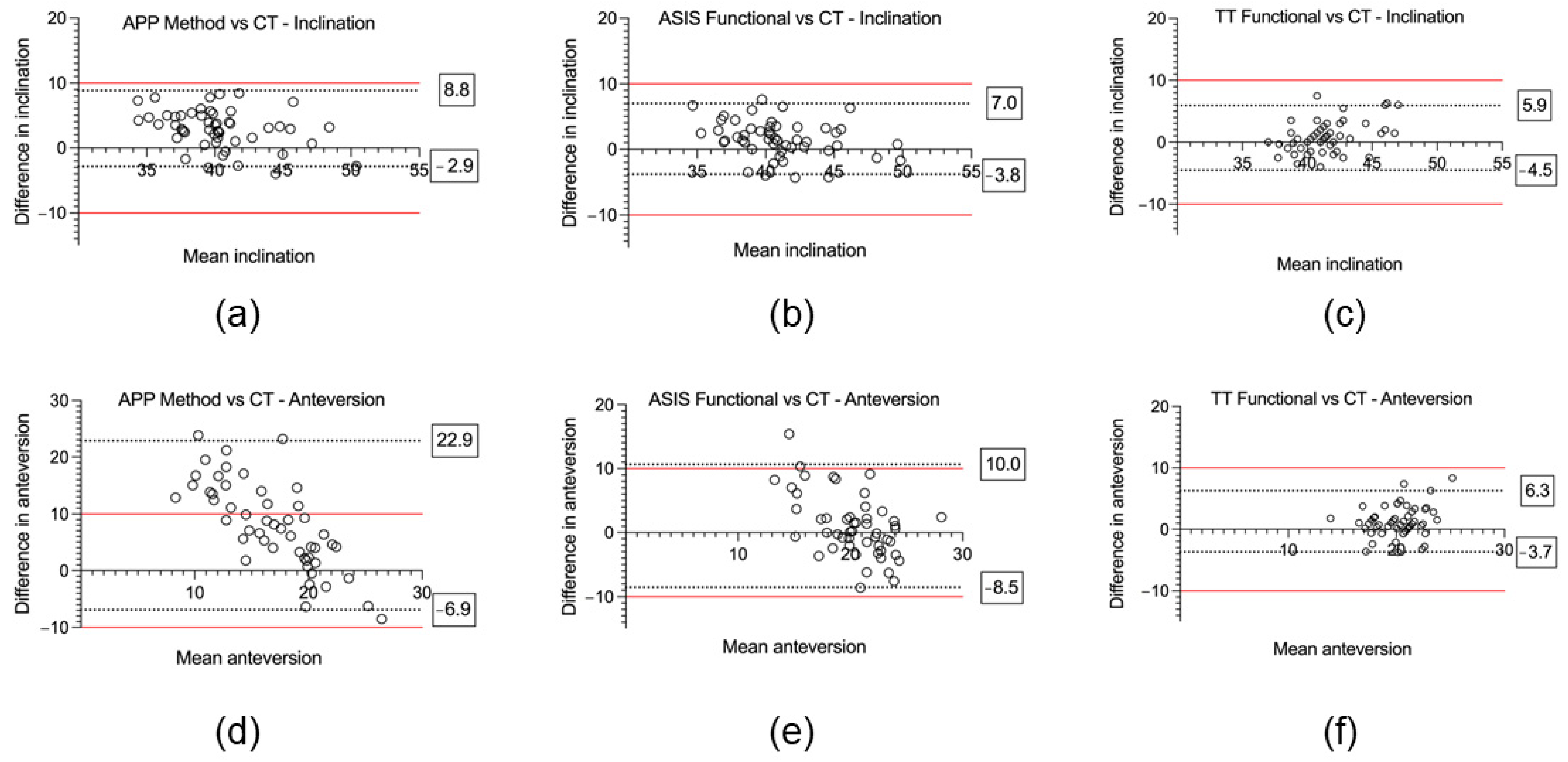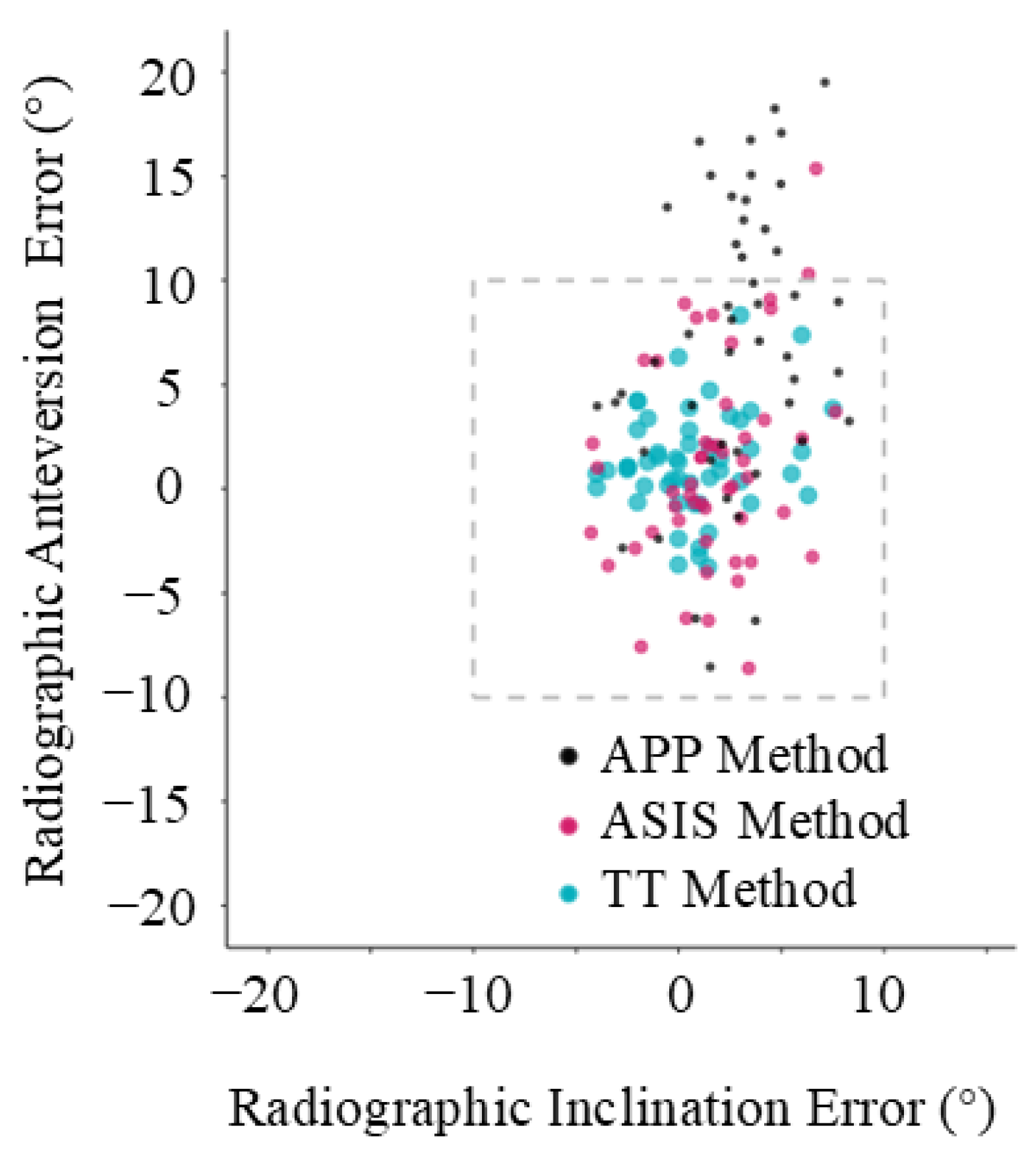Evaluating Alternative Registration Planes in Imageless, Computer-Assisted Navigation Systems for Direct Anterior Total Hip Arthroplasty
Abstract
1. Introduction
2. Materials and Methods
2.1. Study Design
2.2. Registration Methods
2.3. Reference Planes
2.4. Measurement Methods
2.5. Radiographic and Statistical Analysis
3. Results
4. Discussion
5. Conclusions
Author Contributions
Funding
Institutional Review Board Statement
Informed Consent Statement
Data Availability Statement
Acknowledgments
Conflicts of Interest
References
- Biedermann, R.; Tonin, A.; Krismer, M.; Rachbauer, F.; Eibl, G.; Stöckl, B. Reducing the risk of dislocation after total hip arthroplasty: The effect of orientation of the acetabular component. J. Bone Jt. Surg. Br. 2005, 87, 762–769. [Google Scholar] [CrossRef] [PubMed]
- Chai, Y.; Boudali, A.M.; Jenkins, E.; Maes, V.; Walter, W.L. Advances in imaging for pre-surgical planning in hip resurfacing arthroplasty. Orthop. Traumatol. Surg. Res. 2024, 110, 103908. [Google Scholar] [CrossRef]
- Bozic, K.J.; Kurtz, S.M.; Lau, E.; Ong, K.; Vail, T.P.; Berry, D.J. The epidemiology of revision total hip arthroplasty in the United States. J. Bone Jt. Surg. Am. 2009, 91, 128–133. [Google Scholar] [CrossRef]
- Bohl, D.D.; Nolte, M.T.; Ong, K.; Lau, E.; Calkins, T.E.; Della Valle, C.J. Computer-Assisted Navigation Is Associated with Reductions in the Rates of Dislocation and Acetabular Component Revision Following Primary Total Hip Arthroplasty. J. Bone Jt. Surg. Am. 2019, 101, 250–256. [Google Scholar] [CrossRef] [PubMed]
- Hart, A.J.; Muirhead-Allwood, S.; Porter, M.; Matthies, A.; Ilo, K.; Maggiore, P.; Underwood, R.; Cann, P.; Cobb, J.; Skinner, J.A. Which factors determine the wear rate of large-diameter metal-on-metal hip replacements? Multivariate analysis of two hundred and seventy-six components. J. Bone Jt. Surg. Am. 2013, 95, 678–685. [Google Scholar] [CrossRef]
- Elkins, J.M.; Callaghan, J.J.; Brown, T.D. The 2014 Frank Stinchfield Award: The ‘landing zone’ for wear and stability in total hip arthroplasty is smaller than we thought: A computational analysis. Clin. Orthop. Relat. Res. 2015, 473, 441–452. [Google Scholar] [CrossRef]
- Chai, Y.; Boudali, A.M.; Maes, V.; Walter, W.L. Clinical benchmark dataset for AI accuracy analysis: Quantifying radiographic annotation of pelvic tilt. Sci. Data 2024, 11, 1162. [Google Scholar] [CrossRef] [PubMed]
- Barrack, R.L.; Krempec, J.A.; Clohisy, J.C.; McDonald, D.J.; Ricci, W.M.; Ruh, E.L.; Nunley, R.M. Accuracy of acetabular component position in hip arthroplasty. J. Bone Jt. Surg. Am. 2013, 95, 1760–1768. [Google Scholar] [CrossRef]
- Agarwal, S.; Eckhard, L.; Walter, W.L.; Peng, A.; Hatton, A.; Donnelly, B.; de Steiger, R. The Use of Computer Navigation in Total Hip Arthroplasty Is Associated with a Reduced Rate of Revision for Dislocation: A Study of 6912 Navigated THA Procedures from the Australian Orthopaedic Association National Joint Replacement Registry. J. Bone Jt. Surg. Am. 2021, 103, 1900–1905. [Google Scholar] [CrossRef]
- Davis, E.T.; McKinney, K.D.; Kamali, A.; Kuljaca, S.; Pagkalos, J. Reduced Risk of Revision with Computer-Guided Versus Non-Computer-Guided THA: An Analysis of Manufacturer-Specific Data from the National Joint Registry of England, Wales, Northern Ireland and the Isle of Man. JBJS Open Access 2021, 6, e21. [Google Scholar] [CrossRef]
- Davenport, D.; Kavarthapu, V. Computer navigation of the acetabular component in total hip arthroplasty: A narrative review. EFORT Open Rev. 2016, 1, 279–285. [Google Scholar] [CrossRef] [PubMed]
- Pomeroy, C.L.; Mason, J.B.; Fehring, T.K.; Masonis, J.L.; Curtin, B.M. Radiation Exposure During Fluoro-Assisted Direct Anterior Total Hip Arthroplasty. J. Arthroplast. 2016, 31, 1742–1745. [Google Scholar] [CrossRef] [PubMed]
- Chai, Y.; Boudali, A.M.; Walter, W.L. Correlations analysis of different pelvic tilt definitions: A preliminary study. HSS J. 2023, 19, 187–192. [Google Scholar] [CrossRef]
- Pierrepont, J.; Hawdon, G.; Miles, B.P.; Connor, B.O.; Baré, J.; Walter, L.R.; Marel, E.; Solomon, M.; McMahon, S.; Shimmin, A.J. Variation in functional pelvic tilt in patients undergoing total hip arthroplasty. Bone Jt. J. 2017, 99, 184–191. [Google Scholar] [CrossRef]
- Chai, Y.; Boudali, A.M.; Khadra, S.; Walter, W.L.M. The sacro-femoral-pubic angle is unreliable to estimate pelvic tilt: A meta-analysis. Clin. Orthop. Relat. Res. 2022, 10, 1097. [Google Scholar] [CrossRef] [PubMed]
- Chai, Y.; Boudali, A.M.; Khadra, S.; Dasgupta, A.; Maes, V.; Walter, W.L. Evaluating Pelvic Tilt Using the Pelvic Antero-posterior Projection Images-A Systematic Review. J. Arthroplast. 2023, 39, 1108–1116.e2. [Google Scholar] [CrossRef]
- Südhoff, I.; König, C.; Mollard, B.; Sharenkov, A.; Hasart, O.; Heller, M.O. Navigated Ultrasound in Total Hip Arthroplasty; Springer: Berlin/Heidelberg, Germany, 2009. [Google Scholar]
- Chai, Y.; Maes, V.; Boudali, A.M.; Rackel, B.; Walter, W.L. Inadequate Annotation and Its Impact on Pelvic Tilt Measurement in Clinical Practice. J. Clin. Med. 2024, 13, 1394. [Google Scholar] [CrossRef]
- Walter, W.L.; Baker, N.A.; Marsden-Jones, D.; Sadeghpour, A. Novel Measure of Acetabular Cup Inclination and Anteversion During Total Hip Arthroplasty. Med. Devices 2022, 15, 1–14. [Google Scholar] [CrossRef]
- Shatrov, J.; Marsden-Jones, D.; Lyons, M.; Walter, W.L. Improving acetabular component positioning in total hip arthroplasty: A cadaveric study of an inertial navigation tool and a novel registration method. HSS J. 2022, 18, 358–367. [Google Scholar] [CrossRef]
- Murray, D.W. The definition and measurement of acetabular orientation. J. Bone Jt. Surg. Br. 1993, 75, 228–232. [Google Scholar] [CrossRef]
- Lewinnek, G.E.; Lewis, J.L.; Tarr, R.; Compere, C.L.; Zimmerman, J.R. Dislocations after total hip-replacement arthroplasties. J. Bone Jt. Surg. Am. 1978, 60, 217–220. [Google Scholar] [CrossRef]
- Chai, Y.; Boudali, A.M.; Veltman, E.S.; Farey, J.E.; Walter, W.L. Evaluating pelvic tilt using the pelvic antero-posterior radiographs: A novel method. J. Orthop. Res. 2024, 42, 2318–2326. [Google Scholar] [CrossRef] [PubMed]
- Esposito, C.I.; Gladnick, B.P.; Lee, Y.Y.; Lyman, S.; Wright, T.M.; Mayman, D.J.; Padgett, D.E. Cup position alone does not predict risk of dislocation after hip arthroplasty. J. Arthroplast. 2015, 30, 109–113. [Google Scholar] [CrossRef]
- Lin, F.; Lim, D.; Wixson, R.L.; Milos, S.; Hendrix, R.W.; Makhsous, M. Limitations of imageless computer-assisted navigation for total hip arthroplasty. J. Arthroplast. 2011, 26, 596–605. [Google Scholar] [CrossRef]
- Jacob, I.; Benson, J.; Shanaghan, K.; Della Valle, A.G. Acetabular positioning is more consistent with the use of a novel miniature computer-assisted device. Int. Orthop. 2020, 44, 429–435. [Google Scholar] [CrossRef]
- Vigdorchik, J.M.; Sculco, P.K.; Inglis, A.E.; Schwarzkopf, R.; Muir, J.M. Evaluating Alternate Registration Planes for Imageless, Computer-Assisted Navigation During Total Hip Arthroplasty. J. Arthroplast. 2021, 36, 3527–3533. [Google Scholar] [CrossRef]
- Kamenaga, T.; Hayashi, S.; Hashimoto, S.; Matsumoto, T.; Takayama, K.; Fujishiro, T.; Hiranaka, T.; Niikura, T.; Kuroda, R. Accuracy of cup orientation and learning curve of the accelerometer-based portable navigation system for total hip arthroplasty in the supine position. J. Orthop. Surg. 2019, 27, 2309499019848871. [Google Scholar] [CrossRef] [PubMed]
- Okamoto, M.; Kawasaki, M.; Okura, T.; Ochiai, S.; Yokoi, H. Comparison of accuracy of cup position using portable navigation versus alignment guide in total hip arthroplasty in supine position. Hip Int. 2021, 31, 492–499. [Google Scholar] [CrossRef]
- Tetsunaga, T.; Yamada, K.; Tetsunaga, T.; Sanki, T.; Kawamura, Y.; Ozaki, T. An accelerometer-based navigation system provides acetabular cup orientation accuracy comparable to that of computed tomography-based navigation during total hip arthroplasty in the supine position. J. Orthop. Surg. Res. 2020, 15, 147. [Google Scholar] [CrossRef]
- Bradley, M.P.; Benson, J.R.; Muir, J.M. Accuracy of Acetabular Component Positioning Using Computer-assisted Navigation in Direct Anterior Total Hip Arthroplasty. Cureus 2019, 11, e4478. [Google Scholar] [CrossRef]
- Parvizi, J.; Benson, J.R.; Muir, J.M. A new mini-navigation tool allows accurate component placement during anterior total hip arthroplasty. Med. Devices 2018, 11, 95–104. [Google Scholar] [CrossRef] [PubMed]






| Component Position | Post-Operative CT (°) | Reference Plane | Device (°) | Mean Absolute Error ± SD | Bias ± SD (Bland–Altman) | 95% Limits of Agreement (Bland–Altman) | p-Value (Tukey’s HSD) |
|---|---|---|---|---|---|---|---|
| Inclination | 41.5 ± 3.2 | ASIS Anatomic | 38.9 ± 3.7 | 3.7 ± 2.1 | 3.0 ± 3.0 | −2.9 to 8.8 | - |
| ASIS Functional | 39.9 ± 4.0 | 2.8 ± 1.7 | 1.7 ± 3.4 | −4.5 to 5.9 | <0.001 a | ||
| TT Functional | 41.1 ± 2.0 | 2.4 ± 1.7 | 1.6 ± 2.8 | −3.8 to 7.0 | <0.001 b | ||
| Anteversion | 19.7 ± 3.3 | ASIS Anatomic | 13.0 ± 7.3 | 9.1 ± 6.2 | 8.0 ± 7.6 | −6.9 to 22.9 | - |
| ASIS Functional | 19.7 ± 4.8 | 3.9 ± 3.2 | 1.0 ± 4.9 | −8.5 to 10.0 | <0.001 1 | ||
| TT Functional | 19.5 ± 2.4 | 2.4 ± 1.8 | 1.3 ± 2.5 | −3.7 to 6.3 | <0.001 2 0.005 3 |
Disclaimer/Publisher’s Note: The statements, opinions and data contained in all publications are solely those of the individual author(s) and contributor(s) and not of MDPI and/or the editor(s). MDPI and/or the editor(s) disclaim responsibility for any injury to people or property resulting from any ideas, methods, instructions or products referred to in the content. |
© 2024 by the authors. Licensee MDPI, Basel, Switzerland. This article is an open access article distributed under the terms and conditions of the Creative Commons Attribution (CC BY) license (https://creativecommons.org/licenses/by/4.0/).
Share and Cite
Farey, J.E.; Chai, Y.; Xu, J.; Maes, V.; Sadeghpour, A.; Baker, N.A.; Vigdorchik, J.M.; Walter, W.L. Evaluating Alternative Registration Planes in Imageless, Computer-Assisted Navigation Systems for Direct Anterior Total Hip Arthroplasty. Sensors 2024, 24, 7092. https://doi.org/10.3390/s24217092
Farey JE, Chai Y, Xu J, Maes V, Sadeghpour A, Baker NA, Vigdorchik JM, Walter WL. Evaluating Alternative Registration Planes in Imageless, Computer-Assisted Navigation Systems for Direct Anterior Total Hip Arthroplasty. Sensors. 2024; 24(21):7092. https://doi.org/10.3390/s24217092
Chicago/Turabian StyleFarey, John E., Yuan Chai, Joshua Xu, Vincent Maes, Ameneh Sadeghpour, Neri A. Baker, Jonathan M. Vigdorchik, and William L. Walter. 2024. "Evaluating Alternative Registration Planes in Imageless, Computer-Assisted Navigation Systems for Direct Anterior Total Hip Arthroplasty" Sensors 24, no. 21: 7092. https://doi.org/10.3390/s24217092
APA StyleFarey, J. E., Chai, Y., Xu, J., Maes, V., Sadeghpour, A., Baker, N. A., Vigdorchik, J. M., & Walter, W. L. (2024). Evaluating Alternative Registration Planes in Imageless, Computer-Assisted Navigation Systems for Direct Anterior Total Hip Arthroplasty. Sensors, 24(21), 7092. https://doi.org/10.3390/s24217092







